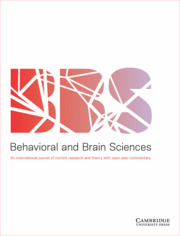Article contents
What is a society? Building an interdisciplinary perspective and why that's important
Published online by Cambridge University Press: 23 February 2024
Abstract
I propose the need to establish a comparative study of societies, conceived of specificially here as bounded groups beyond a simple, immediate family that have the potential to endure for generations, whose constituent individuals recognize one another as members, and that maintain control over a physical space. This definition, with refinements and ramifications I explore, serves for cross-disciplinary research because it applies not just to nations but to diverse hunter–gatherer and tribal groups with a pedigree that likely traces back to the societies of our common ancestor with the chimpanzees. It also applies to groups among other species for which comparison to humans can be instructive. Notably, it describes societies in terms of shared group identification rather than social interactions. An expansive treatment of the topic is overdue given that the concept of a society (even the use of such synonyms as primate “troop”) has fallen out of favor among biologists, resulting in a semantic mess; whereas sociologists rarely consider societies beyond nations, and social psychologists predominantly focus on ethnicities and other component groups of societies. I examine the relevance of societies across realms of inquiry, discussing the ways member recognition is achieved; how societies compare to other organizational tiers; and their permeability, territoriality (allowing for mobile territories), relation to social networks and kinship, and impermanence. We have diverged from our ancestors in generating numerous affiliations within and between societies while straining the expectation of society memberships by assimilating diverse populations. Nevertheless, if, as I propose, societies were the first, and thereafter the primary, ingroups of prehistory, how we came to register society boundaries may be foundational to all human “groupiness.” A discipline-spanning approach to societies should further our understanding of what keeps societies together and what tears them apart.
Keywords
Information
- Type
- Target Article
- Information
- Copyright
- Copyright © The Author(s), 2024. Published by Cambridge University Press
References
- 5
- Cited by



Target article
What is a society? Building an interdisciplinary perspective and why that's important
Related commentaries (24)
A nation by any other name: A failure to focus on function
Belonging to a community of moral values as a key criterion of society
Beyond biology: A sociological stance on what is society
Collective memories and understandings of human societies
Definitions and cultural dynamics in understanding “societies”
Do boundaries matter so much for societies?
Group identity without social interactions?
How an interdisciplinary study of societies can develop a comprehensive understanding of the function of deceptive behavior
Identity groups, perceived group continuity, and schism
Identity is probably too complicated to serve as a useful criterion for defining society
Multi-species societies
Philosophy or science of societies?
Psychological mechanisms for individual recognition- and anonymous-societies in humans and other animals
Revisiting the spaces of societies and the cooperation that sustains them
Societal inferences from the physical world
Societies have functions for individuals and collectives
Societies of the open ocean without territories
Societies, identities, and macrodemes
Society: An anthropological perspective
The family as the primary social group
Understanding the jaggedness in social complexity is more important
Vocalizations are ideal identity signals
What is a society in the case of multilevel societies?
Why societies are important and grow so large: Tribes, nations, and teams
Author response
A society as a clearly membered, enduring, territory-holding group